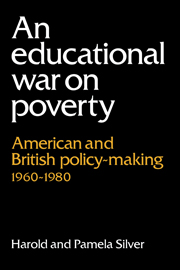Book contents
- Frontmatter
- Contents
- Acknowledgments
- List of abbreviations
- 1 Introduction: a proper complexity
- Part I A pattern of events: United States
- Part II A pattern of events: Britain
- Part III Following through
- 12 United States: planned and unplanned variation
- 13 Britain: units of concern
- 14 Directions
- Interviews and consultation
- Bibliography
- Index
12 - United States: planned and unplanned variation
Published online by Cambridge University Press: 03 October 2009
- Frontmatter
- Contents
- Acknowledgments
- List of abbreviations
- 1 Introduction: a proper complexity
- Part I A pattern of events: United States
- Part II A pattern of events: Britain
- Part III Following through
- 12 United States: planned and unplanned variation
- 13 Britain: units of concern
- 14 Directions
- Interviews and consultation
- Bibliography
- Index
Summary
From 1967 and through the 1970s the American war on poverty subsided, fluctuated, but continued, in some of its original forms, in new forms, with the same or different emphases, and new efforts to understand and evaluate the educational strategies by which the campaigns were or could be conducted. Head Start and Title I of the ESEA remained central policy pivots, joined particularly by Follow Through, new local and state-wide projects, new sponsors, new figures in the landscape. There were other continuities, however, in the shadow of the doubts cast by the Coleman report in 1966 on the effectiveness of schooling, and from 1969 by a dispiriting report on Head Start from the Westinghouse Learning Corporation and Ohio University. Evaluation was to be the watchword of 1970s policy-making and funding, and in relation to all the major programmes it was to become increasingly – and contentiously – part of an attempt more reliably and publicly to judge their principles, procedures and outcomes. Hed Start, Title I and Follow Through looked to new and diverse models of educational practice and in doing so spawned questions of comparative ‘ effectiveness’, giving rise to a generation of academic consultants and commentators, and professionals sited in project or state-wide or district education offices. Evaluators helped to plan campaigns, and walked with the troops, judged their successes and failures, and established evaluation as a branch of educational campaign management, as of other types of legislative and executive warfare.
- Type
- Chapter
- Information
- An Educational War on PovertyAmerican and British Policy-making 1960–1980, pp. 257 - 286Publisher: Cambridge University PressPrint publication year: 1991



